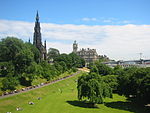Freemasons' Hall, Edinburgh
Category A listed buildings in EdinburghFreemasonry in ScotlandMasonic buildings in ScotlandNew Town, Edinburgh

Freemasons' Hall in Edinburgh, Scotland, is the headquarters of Scottish Freemasonry, the Grand Lodge of Scotland. It is located at 96 George Street.A Category A listed building, the hall was built during 1911–1912 and was designed by the Edinburgh architect Alexander Hunter Crawford. Crawford was himself a prominent freemason, and the hall is described as his most important work. The facade of the building features a large statue of St Andrew, by the sculptor Henry Snell Gamley. The building replaced a previous hall erected in 1858, designed by David Bryce.
Excerpt from the Wikipedia article Freemasons' Hall, Edinburgh (License: CC BY-SA 3.0, Authors, Images).Freemasons' Hall, Edinburgh
George Street, City of Edinburgh New Town
Geographical coordinates (GPS) Address Nearby Places Show on map
Geographical coordinates (GPS)
| Latitude | Longitude |
|---|---|
| N 55.95244 ° | E -3.20256 ° |
Address
Freemasons Hall
George Street 96
EH2 3BU City of Edinburgh, New Town
Scotland, United Kingdom
Open on Google Maps









